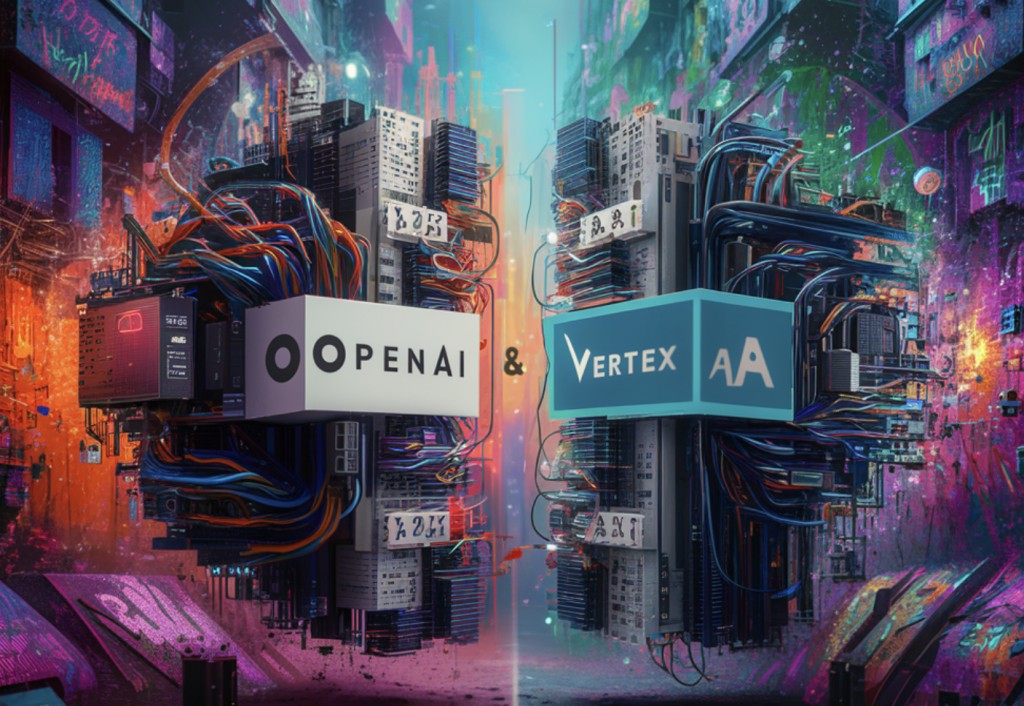As of 2024, OpenAI and Vertex AI are two of the most influential titans in the AI domain. These platforms, backed by leading tech giants, showcase their unique strengths and applications in AI, fostering advancements and providing tools for developers, researchers, and businesses alike.
OpenAI, known for its revolutionary GPT AI models, excels in advanced natural language processing and generative AI tasks. Its array of products, including the versatile GPT-4, DALL-E for image generation, and Whisper for speech-to-text capabilities, cater to a wide spectrum of applications from creative writing to customer service automation. OpenAI’s technology is particularly celebrated for its depth in understanding and generating human-like text, making it a go-to for sectors reliant on nuanced language generation.
OpenAI Key Features:
GPT (Generative Pre-trained Transformer): Flagship AI model known for exceptional language understanding and generation capabilities.
ChatGPT: A conversational model that engages in detailed and coherent discussions across various topics.
DALL-E: An image generation model that creates original, high-quality images from textual descriptions, disrupting creative industries.
Whisper: Advanced speech-to-text model for accurate transcription and language translation, enhancing global communication.
Text-to-Video: The Sora model enables the creation of realistic video scenes from text inputs, pushing the boundaries of content creation.
Developer Platform: Offers comprehensive resources, tutorials, and API documentation for developers to integrate AI functionalities into applications.
OpenAI Pros:
Unmatched natural language processing capabilities make it highly effective for creative writing, customer service, and more.
Its models are versatile across various tasks, enhancing a range of creative and technical endeavours.
Regular updates and improvements to its AI models ensure state-of-the-art solutions.
OpenAI Cons:
Intensive use of API calls can lead to significant expenses, which may not be ideal for all users.
Models like DALL-E and ChatGPT sometimes diverge from user prompts, leading to unexpected results.
The advanced capabilities of its products can introduce a steep learning curve for optimal use.
Google’s Vertex AI is a robust platform designed to develop, deploy, and manage AI and machine learning models at scale. It aims to democratise AI development with features like AutoML and integrated ML workflows. Its offerings, such as Gemini multimodal models and over 130 generative AI models, equip businesses across industries with the tools to enhance content creation, customer engagement, and more.
Vertex AI Key Features:
Gemini Multimodal Models: Processes and generates outputs from diverse inputs like text, images, video, or code, ideal for media and e-commerce.
Generative AI Models and Tools: Over 130 generative AI models, including first-party and third-party models, are available for extensive customisation.
AutoML: Allows users with limited machine learning expertise to leverage Google’s AI technology effectively.
MLOps Tools: Purpose-built tools designed to automate, standardise, and manage ML projects throughout their lifecycle.
Search and Conversation: Enables developing and deploying AI-powered search and chatbot applications with enterprise-ready data privacy.
Integration with Google Cloud Services: Offers seamless integration, enhancing operational efficiency and collaboration within the Google ecosystem.
Vertex AI Pros:
Offers an unmatched variety of over 130 models, enabling extensive customisation and specific tuning.
Excelling in tasks requiring understanding and generation from diverse inputs such as text, images, and video.
Enhances operational efficiency and collaboration, making it ideal for businesses already using Google’s ecosystem.
Vertex AI Cons:
The platform’s extensive features can overwhelm newcomers to AI and machine learning.
Deep integration with Google Cloud may restrict flexibility for users entrenched in other cloud services.
Some models, like Gemini, have been reported to produce biased outputs, raising concerns about their training and validation processes.
Comparative Analysis
Several key aspects stand out when comparing the two platforms. OpenAI’s GPT-4 offers superior natural language processing capabilities, making it the preferred choice for tasks that require advanced language understanding and generation. Meanwhile, Vertex AI’s broad suite of tools and models, especially its AutoML features and MLOps support, provide a more versatile solution for complex AI projects. However, it may present a steeper learning curve for some users.
The choice between OpenAI and Vertex AI largely depends on the users’ specific needs and objectives. Those prioritising advanced language capabilities and ease of implementation might lean towards OpenAI, while users looking for a comprehensive set of tools for machine learning and AI model management might find Vertex AI more appealing.
Comparative Table
Conclusion
The landscape of artificial intelligence in 2024 is distinctly marked by the pioneering advancements and broad applications offered by both OpenAI and Vertex AI. While OpenAI leads with its unparalleled natural language processing and generative AI capabilities, ideal for creative endeavours and nuanced language tasks, Vertex AI carves its niche with a comprehensive suite of AI model development and deployment tools catering to a broader spectrum of machine learning applications. The decision between these AI powerhouses ultimately hinges on the user’s specific requirements, whether the priority lies in the depth of language understanding and creativity offered by OpenAI or the versatility and integration capabilities of Vertex AI’s extensive platform.Â
The post OpenAI vs. Vertex AI: A Comparison of Two Artificial Intelligence (AI) Powerhouses in 2024 appeared first on MarkTechPost.
Source: Read MoreÂ

